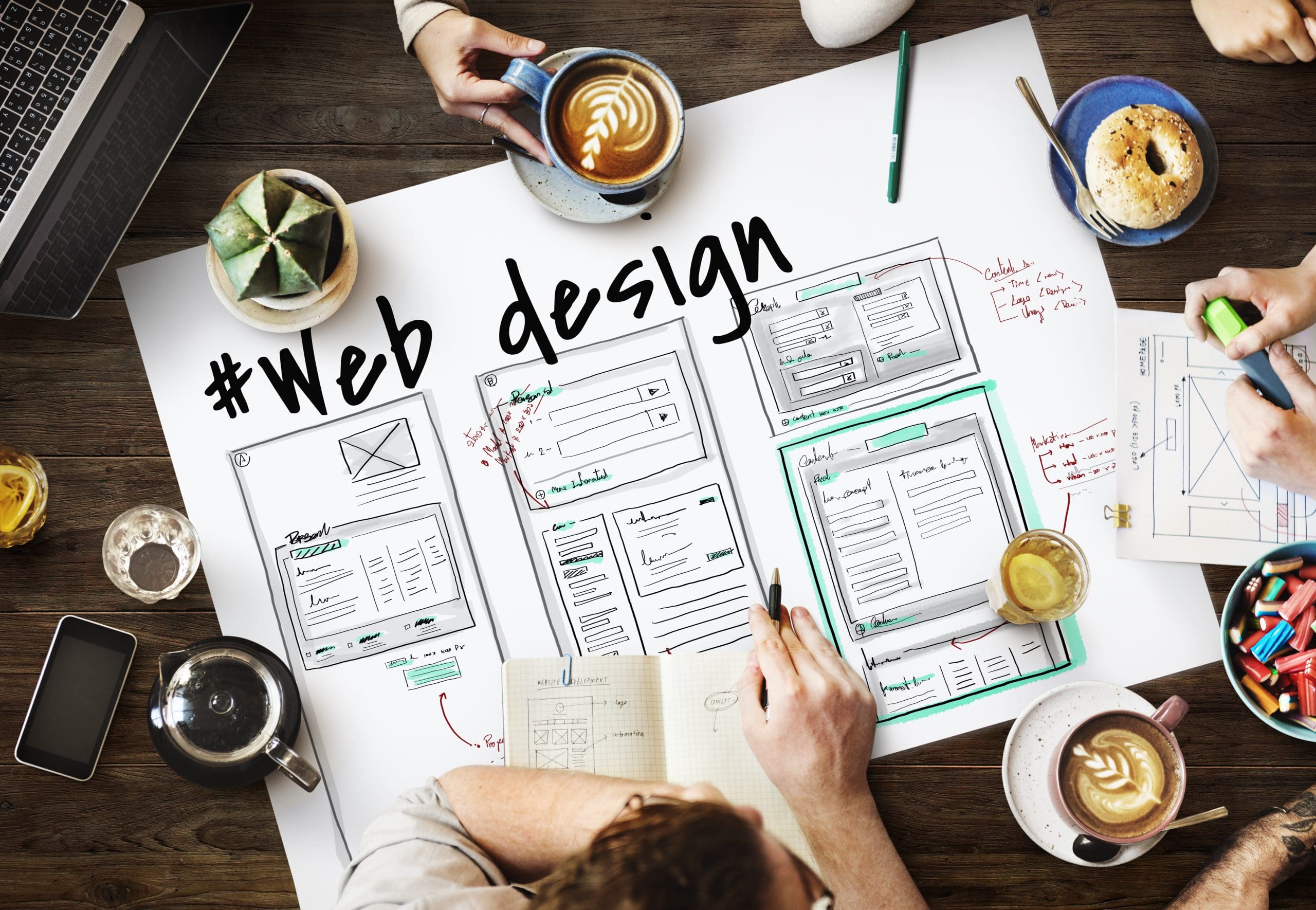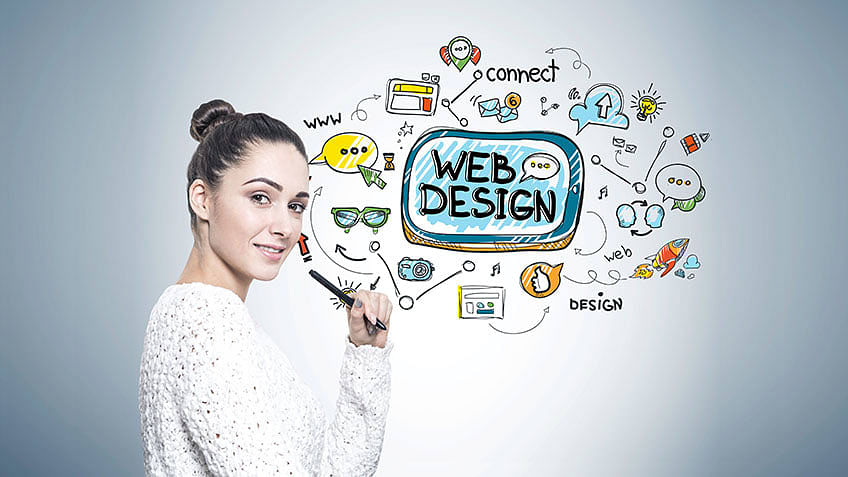Checking Out Creative Fads in Web Design for Modern Organizations
The landscape of web design is continuously progressing, mirroring the dynamic requirements of contemporary businesses. Current trends highlight a choice for minimalism, bold typography, and engaging interactivity. Companies progressively focus on user experience through mobile-first principles and customized web content. Additionally, a focus on sustainability is acquiring traction. Understanding these trends is essential for organizations intending to stand out in a crowded market. What ramifications do these shifts hold for the future of electronic engagement?
Embracing Vibrant Typography
Strong typography has actually arised as a specifying aspect in contemporary web design, recording interest and conveying messages with striking clearness. This trend prioritizes aesthetically impactful text that enhances user interaction and brand name identity. Designers typically utilize oversized typefaces and unique typefaces to create a pecking order, assisting viewers with web content perfectly.
The tactical use of bold typography permits reliable storytelling, enabling brand names to interact their values succinctly. It offers not just aesthetic objectives however also useful ones, as it improves readability across tools and screen sizes.
As web sites compete for user interest, bold typography attracts attention in a saturated digital landscape. Its flexibility enables developers to try out contrasting designs and shades, additionally magnifying its effectiveness. Ultimately, embracing strong typography stands for a change in the direction of more communicative and meaningful web design, cultivating a deeper connection in between brands and their target markets.
The Surge of Minimalist Layout
As digital atmospheres become increasingly messy, the increase of minimal layout uses a rejuvenating option that prioritizes simplicity and capability. This layout philosophy remove unnecessary components, permitting material to take facility phase. By concentrating on clean lines, sufficient white room, and a minimal shade palette, minimal style improves user experience and improves navigating.
Organizations adopting this pattern objective to communicate their brand message plainly and successfully, promoting a sense of calm and clearness. The lack of diversions aids users focus on necessary information, leading to improved involvement and conversion rates. Furthermore, minimalist layout aligns well with mobile-first strategies, ensuring that sites continue to be easy to use and available across various gadgets.
Eventually, the rise of minimalist layout mirrors a more comprehensive shift in the direction of focusing on user demands and choices, making it a powerful device for contemporary companies looking to make a long-term impact in the digital landscape.
Immersive Animations and Interactivity
While lots of internet designers welcome minimal aesthetic appeals, another compelling fad obtaining grip is making use of immersive computer animations and interactivity. This approach enhances user engagement by producing fascinating experiences that attract site visitors right into the web content. Developers employ dynamic components such as animated backgrounds, scrolling impacts, and interactive infographics to interact intricate ideas in an easily accessible way.
These animations not just give aesthetic interest yet likewise overview customers with the navigating procedure, making communications more instinctive. Float effects and computer animated changes can encourage users to check out better, leading to increased time invested on the website.
In addition, this fad lines up with the more comprehensive movement towards narration in web design, where animations work as narrative gadgets that share brand name messages efficiently. By incorporating immersive animations and interactivity, businesses can distinguish themselves in a congested online landscape, ultimately improving user satisfaction and brand name commitment.
Mobile-First Layout Principles
Mobile-first layout concepts emphasize focusing on user experience by guaranteeing internet sites operate flawlessly on smaller screens. This approach incorporates responsive design strategies that adapt to different device sizes while preserving visual integrity. In addition, it concentrates on touchscreen navigation style, boosting use for mobile customers.
Focusing On User Experience
Exactly how can designers properly prioritize user experience in an increasingly mobile-centric globe? Highlighting mobile-first style concepts is essential, as users mostly involve with internet sites with mobile devices. This method motivates designers to streamline content, guaranteeing it is conveniently obtainable and accessible on smaller displays. Trick practices consist of streamlining navigating, minimizing load times, and utilizing touch-friendly aspects that improve interactivity. In addition, prioritizing clear typography and instinctive formats can considerably improve user contentment. Designers ought to continuously gather user feedback to fine-tune their approaches, adjusting to advancing user demands and choices. By concentrating on these aspects, organizations can develop an interesting electronic experience that fosters loyalty and drives conversions, inevitably aligning with the assumptions these days's mobile customers.
Receptive Design Strategies
Developers accept receptive layout methods to create flexible and flexible internet experiences that deal with various screen sizes. This approach focuses on mobile-first design principles, making sure peak functionality on smaller sized devices prior to scaling up for larger screens. By using liquid grids, discover this info here adaptable photos, and media inquiries, designers can preserve a natural visual identification across all platforms. This technique not only boosts user involvement yet also boosts internet search engine positions, as mobile-friendly websites are preferred by search algorithms. Additionally, receptive designs allow businesses to get to a broader target market, suiting individuals on tablet computers, desktops, and mobile phones alike. On the whole, implementing these techniques is important for contemporary web design, ensuring that businesses remain competitive in an ever-evolving electronic landscape.
Touchscreen Navigating Style
With the rise of mobile devices, touchscreen navigation has ended up being a fundamental facet of web design. Developers are progressively adopting mobile-first concepts to improve user experience and engagement. Web Design services. Reliable touchscreen navigation prioritizes larger buttons and instinctive gestures, allowing customers to communicate conveniently with web content. This technique decreases irritation and motivates expedition, as customers can navigate flawlessly with their fingers. In addition, integrating swipe motions and tap functionality satisfies the all-natural actions of mobile customers. Responses mechanisms, such as aesthetic hints and computer animations, boost use additionally by confirming actions. As touchscreens control user interactions, using these layout aspects not just straightens with modern-day assumptions yet also promotes a more accessible and pleasurable browsing experience for all customers
Individualized User Experiences
What makes a user feel genuinely involved on a website? The solution typically depends on personalized user experiences. By tailoring material and navigating to specific preferences, services can create a meaningful connection with their target market. This personalization can be achieved with different techniques, such as examining user habits, making use of cookies, and offering customized suggestions based upon previous interactions.
For instance, ecommerce platforms that recommend products based on browsing history not only enhance user experience however additionally increase conversion rates. Including dynamic material that adapts to the user's area or time of day can better improve interaction.
Furthermore, tailored greetings or messages can make users feel valued and recognized. As modern-day businesses venture to stand out in an affordable electronic landscape, welcoming individualized user experiences ends up being vital, promoting commitment and encouraging repeat visits. Ultimately, this technique transforms a standard internet site right into an interactive system that resonates with its target market.
Sustainability in Web Design
As the digital landscape remains to progress, the significance of sustainability in web design has actually obtained substantial interest. Developers are significantly aware of the environmental influence their creations can have, motivating a shift towards green practices (agency for web design). Lasting web design concentrates on maximizing internet sites to reduce power usage and carbon impacts. Strategies include utilizing minimalistic design principles, optimizing images, and using effective coding methods to improve loading rates
Additionally, the option of holding service providers plays a necessary duty; many developers are now selecting eco-friendly hosting solutions powered by eco-friendly energy. By prioritizing availability and straightforward navigation, lasting styles also cater to a more comprehensive audience, enhancing functionality. This conscious strategy not only attract website here environmentally-minded consumers but additionally adds to the total longevity and performance of internet sites. Ultimately, sustainability in web design reflects a growing pattern towards accountable electronic techniques that straighten with contemporary service worths.

Regularly Asked Concerns
Exactly How Can I Choose the Right Color Design for My Web site?
To pick the right color design for a website, one ought to consider the brand name's identity, target market, and psychological influence. Utilizing shade theory and testing mixes can boost user experience and aesthetic appeal considerably.
What Are the most effective Tools for Prototyping Website Design?
The finest tools for prototyping website design include Figma, Sketch, Adobe XD, and InVision. These platforms provide instinctive user interfaces, collaboration attributes, and substantial collections, making them ideal for developers to develop and fine-tune their principles properly.
Exactly how Do I Gauge the Effectiveness of My Web Design?
To measure web design effectiveness, one need to evaluate user engagement metrics, conversion rates, and use responses (web design company). A/B testing and heatmaps can likewise offer insights right into user actions, assisting required modifications for enhanced performance and user experience
What Prevail Web Design Mistakes to Stay Clear Of?
Usual web design blunders consist of messy layouts, inadequate navigating, slow packing times, lack of mobile optimization, inadequate comparison, and neglecting user comments. Avoiding these mistakes improves user experience and increases total effectiveness of the site.
How Commonly Should I Update My Web Site Design?
An internet site style should be upgraded every a couple of years, or sooner if substantial modifications in branding or technology happen. Regular updates Get More Info keep the site fresh, useful, and lined up with present user assumptions.
